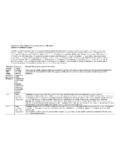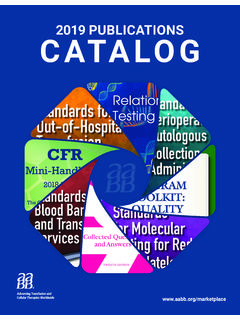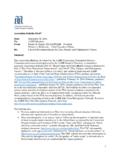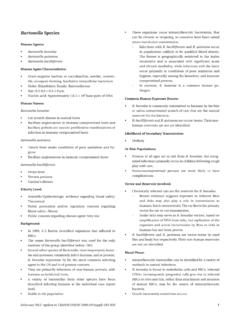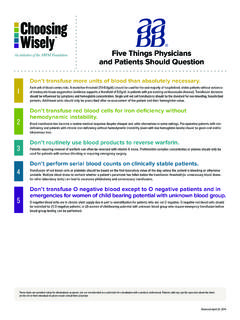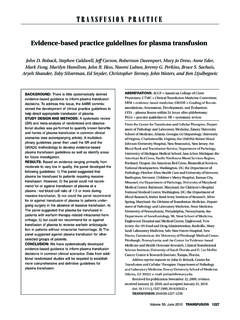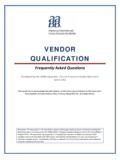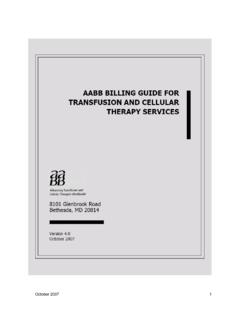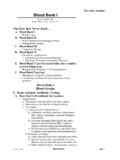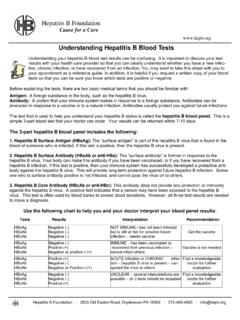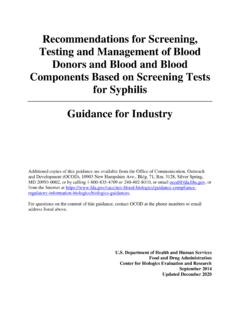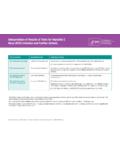Transcription of Association Bulletin #16-02 AABB Members Donna …
1 Association Bulletin #16-02 Date: January 15, 2016 To: aabb Members From: Donna M. Regan, MT(ASCP)SBB President Miriam A. Markowitz Chief Executive Officer Re: Mitigating the Anti-CD38 Interference with Serologic Testing Summary A new class of therapeutic agents for multiple myeloma, CD38 monoclonal antibodies, can result in interference with blood bank serologic tests and thereby cause delays in issuing Red Blood Cell (RBC) units to patients receiving these agents. To minimize these delays, hospitals should set up procedures to inform the transfusion service when patients start receiving these agents. Considerations for the transfusion service, both before and after initiation of anti-CD38 therapy, are detailed below. The aabb Clinical Transfusion Medicine Committee has developed this Bulletin to provide background information and guidance to Members regarding anti-CD38 interference with serologic testing. The Bulletin includes recommendations for its prevention and treatment.
2 Association Bulletins, which are approved for distribution by the aabb Board of Directors, may include announcements of standards or requirements for accreditation, recommendations on emerging trends or best practices, and/or pertinent information. This Bulletin contains information and recommendations. No new standards are proposed. Background CD38 monoclonal antibodies are a new treatment for multiple myeloma CD38, an integral membrane protein that is highly expressed on myeloma cells, has been identified as an effective target antigen for monoclonal antibody therapies. In November 2015, the first therapeutic CD38 monoclonal antibody [daratumumab (Darzalex, Janssen Biotech, Horsham, PA)] was approved by the Food and Drug Other CD38 monoclonal antibodies are under development. CD38 monoclonal antibodies interfere with blood bank serologic tests CD38 is weakly expressed on red cells. Anti-CD38 binds to CD38 on reagent RBCs, causing panreactivity in ,3 Plasma samples from anti-CD38-treated patients consistently cause positive reactions in indirect antiglobulin tests (IATs), antibody detection (screening) tests, antibody identification panels, and antihuman globulin (AHG) crossmatches.
3 Agglutination due to anti-CD38 may occur in all media (eg, saline, low ionic strength saline, polyethylene glycol), 1 and with all IAT methods (eg, gel, tube, solid phase). Agglutination reactions caused by anti-CD38 are usually weak (1+), but stronger reactions (up to 4+) may be seen in solid-phase testing. However, anti-CD38 does NOT interfere with ABO/RhD typing or with immediate-spin crossmatches. Other notes on anti-CD38 serologic interference: Adsorptions using either untreated or ZZAP-treated cells fail to eliminate the interference. Anti-CD38 variably interferes with direct antiglobulin tests (DATs) and antibody identification panel autocontrols. Some rare Lu(a b ) cells are not reactive in the presence of anti-CD38, potentially giving the false impression that the patient has a Lutheran-related ,5 Positive IATs can be observed for up to six months after anti-CD38 is ,3 Anti-CD38 may cause a small decrease in hemoglobin in vivo (~1 g/dL), but severe hemolysis has not been observed among treated ,6 Anti-CD38 interference can cause delays in issuing RBCs If the transfusion service is unaware that a patient has received anti-CD38, the following scenario may occur when the patient s sample is tested: 1.
4 ABO/RhD typing: no issues. 2. antibody detection (screening) test: all cells positive. 3. antibody identification panel: all cells positive (autocontrol may be negative). 4. DAT: positive or negative. 5. AHG crossmatches: positive with all RBC units tested. 6. Adsorptions: panreactivity cannot be eliminated. This leads to delays in issuing RBCs to the patient. In some cases, the anti-CD38 interference could mask the presence of a clinically significant alloantibody. Recommendations To avoid problems with transfusion, hospitals should set up procedures to inform the transfusion service whenever any patient is scheduled to begin taking anti-CD38. BEFORE a patient begins taking anti-CD38: A baseline type and screen should be performed. In addition, a baseline phenotype or genotype is recommended. AFTER a patient begins taking anti-CD38: ABO/RhD typing can be performed normally. For antibody detection (screening) and identification, dithiothreitol (DTT)-treated cells can be used to eliminate the ,7 o Because DTT treatment destroys Kell antigens, K-negative units should be provided unless the patient is known to be K-positive.
5 O Antibodies against other DTT-sensitive blood group antigens (anti-k, anti-Yta, anti-Doa/Dob, etc) will not be detectable when the antibody screen with DTT-2 treated cells is performed; such antibodies are encountered infrequently, however. Crossmatch For patients with a negative antibody screen using DTT-treated cells, an electronic or immediate-spin crossmatch with ABO/RhD-compatible, K-matched units may be performed. For patients with known alloantibodies, phenotypically or genotypically matched RBC units may be ,8 o As some typing antisera require the use of AHG, phenotyping should be performed before the patient receives anti-CD38. o Genotyping can be performed either before or after the patient receives anti-CD38. o AHG crossmatches with phenotypically or genotypically matched units will still be incompatible. o Some clinically significant antibodies may be missed with the use of uncrossmatched phenotypically or genotypically matched units, although this will occur infrequently.
6 Alternatively, an AHG crossmatch may be performed using DTT-treated donor cells. If an emergency transfusion is required, uncrossmatched ABO/RhD-compatible RBCs may be given per local blood bank practices. Future/alternative approaches to mitigating the anti-CD38 interference It is possible to neutralize anti-CD38 in plasma and eliminate the interference using either recombinant soluble human CD38 or daratumumab idiotype ,3 Neither reagent is widely available at this time, and additional validation would be needed. In principle, soluble CD38 could be used to neutralize any anti-CD38, while different idiotype antibodies would be needed to neutralize different CD38 therapeutic antibodies. Finally, antigen-typed cord cells have been used for the antibody screen as an alternative to DTT-treated 3 References 1. Darzalex package insert. Horsham, PA: Janssen Biotech, 2015. [Available at: (accessed January 7, 2016).] 2. Chapuy CI, Nicholson RT, Aguad MD, et al.
7 Resolving the daratumumab interference with blood compatibility testing. Transfusion 2015;55(6pt2):1545-54. 3. Oostendorp M, Lammerts van Bueren JJ, Doshi P, et al. When blood transfusion medicine becomes complicated due to interference by monoclonal antibody therapy. Transfusion 2015;55(6pt2):1555-62. 4. Velliquette RW, Shakarian G, Jhang J, et al. Daratumumab-derived anti-CD38 can be easily Mistaken for clinically significant antibodies to Lutheran antigens or to Knops antigens (abstract). Transfusion 2015;55(3S):26A. 5. Aye T, Arndt PA, Leger RM, et al. Myeloma patients receiving daratumumab (anti-CD38) can appear to have an antibody with Lutheran-related specificity (abstract). Transfusion 2015;55(3S):28A. 6. Chari A, Satta T, Tayal A, et al. (2015, December) Outcomes and management of red blood cell transfusions in multiple myeloma patients treated with daratumumab (oral and poster abstract presented Monday, December 7, 2015, 6:00 PM-8:00 PM at 57th Annual American Society of Hematology meeting).
8 Blood 2015;26(Suppl):Abstract 3571. 7. Chapuy CI, Aguad MD, Nicholson RT, et al. International validation of a dithiothreitol (DTT)-based method to resolve the daratumumab interference with blood compatibility testing (oral and poster abstract presented Monday, December 7, 2015, 6:00 PM-8:00 PM at 57th Annual American Society of Hematology meeting). Blood 2015;126(Suppl):Abstract 3567. 8. Hannon JL, Caruk B, Clarke G. Serological findings related to treatment with a human monoclonal antibody (daratumumab) in patients with advanced plasma cell myeloma (abstract). Transfusion 2014;54(2S):162A. 9. Schmidt AE, Kirkley S, Patel N, et al. An alternative method to dithiothreitol treatment for antibody screening in patients receiving daratumumab (abstract). Transfusion 2015;55(3S):2292-3. 4

